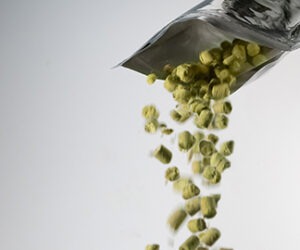Aeration: Tips from the Pros
Oxygen is an enemy of beer. Let this gas find its way into your finished brew and — ack! — your entire award-winning batch can quickly go stale. However, there is a time when oxygen is a brewer’s friend. Yeast cells need oxygen to make components of their cell membranes when they grow. So you need to aerate your wort after it is cooled but before fermentation. Here’s how.
Brewer: Ashton Lewis, Springfield Brewing Company in Springfield, MO.
When I think of aeration, what comes to mind is that I’m setting the stage for a good fermentation. Basically, brewers manage three things in setting the stage for fermentation. First, they make the wort. Then they cool it to a certain temperature. And finally, they aerate.
What I rarely see mentioned is that brewers can manipulate the level of aeration in order to get different results in their beer. I worked with a brewery in Japan and one of their flagship beers was going to be a weizen. The brewers wanted to get a fruitier flavor in that beer, so less aeration was worked into the recipe. The fact is that limiting aeration produces more esters, so what you end up with is a fruitier beer. It’s possible, then, to intentionally under-aerate if you want more ester characteristics in a particular beer. Conversely, it’s also possible to reduce ester production through good aeration practices.
In high-gravity beers, the increased wort concentration decreases oxygen solubility. In something like a doppelbock, for instance, you really need to make the effort to get more oxygen into the wort to reduce esters.
There’s a good chance you’ll have less oxygen in a homebrewed beer that’s just “splashed” against the side of a fermenter, or maybe shaken up a bit, compared to aeration methods that actively inject air or oxygen into the wort stream. One option for homebrewers is the “Oxynater.” This is an oxygenating system that consists of a small tank of pure oxygen and a hose equipped with a stainless-steel aeration stone. The hose and stone are inserted into your chilled wort and then the oxygen valve on the tank is opened. The oxygen percolates through the device, saturating the wort. Homebrewers might also opt for a system that uses an aquarium pump connected to an aeration stone.
Ideal oxygen levels are between eight to ten parts per million (ppm). However, when you use pure oxygen you can get oxygen levels exceeding 20 ppm. This means that you can overdo it if you don’t have the tools to measure oxygen flow and oxygen content. Since most homebrewers lack these instruments, I recommend taking good notes when using pure oxygen and determining by trial and error what works well.
Just as too little oxygen can be bad, too much oxygen can also have a negative impact on the beer — especially if you also pitch too much yeast. What could happen, essentially, is you’ll end up with beer that has very little character. There are flavors produced when yeast is growing, but if you start with a large quantity of yeast and excessive oxygen, the yeast will not need to struggle and multiply to ferment out the sugars in the wort. In this case, they will not impart important flavors and aroma to the beer.
Homebrewers can’t overdo it, however, when they use air. This is because the oxygen saturation in wort is only about eight parts per million when air (as opposed to oxygen) is used for aeration. At full speed with an aquarium pump, you can add air for ten minutes. Next time, maybe run it for 15–20 minutes as an empirical test. If you find no change in fermentation rate or changes in taste, then you know ten minutes is probably enough time to saturate the wort with oxygen.
At Springfield Brewing Company, we use an in-line device for wort aeration called the “Turbo Air” (see photo). This unit uses dry, compressed air that is filtered through a sterile filter. When this thing is in use it has this really cool humming sound, and the wort resembles milk as it passes through a sight glass at the far end of the unit.
Brewer: Mike Snyder, Cedar Brewing Company in Cedar Rapids, IA.
The only time you want to introduce oxygen into beer is when you pitch the yeast. The yeast needs plenty of oxygen to make it multiply and ferment quickly. Without aeration, the lag time — the time from pitching to the start of fermentation — will be extended and the risk of bad bacteria taking over the fermentation will be much higher.
When I was a homebrewer, I used a 7.5-gallon plastic bucket as my fermenter. As soon as I pitched the yeast in the bucket, I whipped up the wort with a sanitized stainless-steel whisk. The whipping causes oxygen in the surrounding air to be introduced into the wort. It is very important to make sure the whisk is clean and sanitized. I continued whipping until the froth was up to the top of the bucket, then pitched the yeast and put the lid and airlock on. Many homebrewers think it’s enough just to splash the beer into the bucket. In most cases, this is true. You’ll still get fermentation, but probably with a longer lag time. So the more oxygen you introduce during pitching, the better.
At Cedar Brewing, I inject medical-grade oxygen directly into the wort as it is transferred from the brew kettle to the fermenter. This is after it is chilled through the heat exchanger. This is accomplished through a small sintered stainless stone, which is inside a sight glass. Since we are a small brewpub, I do not have the equipment to determine the exact concentration of oxygen (in ppm) that is injected. I simply go by the pressure on the gauge and time.
My advice to homebrewers on achieving “good” aeration levels is this: anything is better than nothing. If you have a carboy and can’t whip up the chilled wort, make sure you splash the wort aggressively as it goes into the carboy. Or shake it all up once you are done transferring to the carboy. Do your best to introduce as much oxygen as possible into your wort. In this case, it’s your friend.
Brewer: Will Gilson, Moat Mountain Smokehouse and Brewing Company in North Conway, NH.
Oxygen is a necessary element for yeast to metabolize. The brewer’s goal is to get the yeast to take over the wort in the fermenter as quickly as possible. With so many nutrients in the wort, that really isn’t hard to do. You just need to give them their basic element — oxygen — so they can perform their job.
One way to limit lag time is to make a yeast starter and pitch it when the starter is at a full kraeusen. To make a yeast starter, boil one cup of dry malt extract and chill it to pitching temperature, keeping it sterile. Pitch your yeast into the starter. Once it’s obviously fermenting strongly, you can pitch that into your five-gallon batch.
Without good aeration, however, your yeast still might have a hard time taking off. There are two things to consider about aeration. First, it’s important for the aeration to be on the “cold side.” In other words, you want to aerate once the wort has cooled to fermentation temperature.
My aeration set-up consists of a basic fish-tank pump, connected to a length of sterile hose, which goes into a sterile filter. Another length of sterile hose comes out the other end, with a carbonating stone attached on the end. This might be a plastic stone from a fish shop, but these tend to have big holes so the oxygen that comes out of it doesn’t go into solution so well. A ceramic stone with smaller holes usually works better. You might also want a weight to hold the stone beneath the surface of the wort.
Sanitize the hoses, put the end of the hose in the chilled wort, turn on the pump and let it go for 10–15 minutes. You should get an inch or two of foam on top of the wort.
Low-tech aeration can be nothing more than swirling the wort with a spoon or pouring the wort back and forth from bucket to bucket. Remember that homebrewing is as complicated as you make it. It’s up to you to decide where you want to pay special attention to detail.



